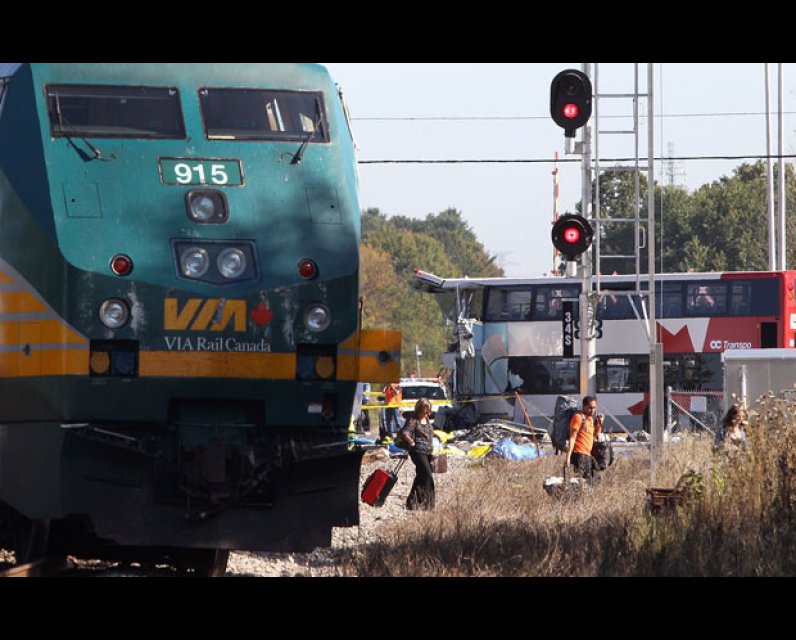Unpublished Opinions
Unpublished.ca is a web portal on politics and current affairs in Canada. It provides the opportunity for Canadians to dig deeper into the issues affecting them, and to weigh-in on these issues in a persuasive and respectful way. Join the movement and have your say today!
TSB Rail Safety Advisory Letter re: Reported malfunction of transitway automatic crossing protection

On Feb. 25th, the Transportation Safety Board of Canada issued two letters to the City of Ottawa regarding their investigation into the OC Transpo Via Rail bus crash on September 18, 2013. This is the second letter of the two.
Below the letter you will find the City's response in a memo to the Mayor and City Council from Deputy City Manager Steve Kanellakos.
Click here to read the 1st letter.
25 February 2014
His Worship Jim Watson
Mayor, City of Ottawa
110 Laurier Avenue West
Ottawa, Ontario
K1P 1J1
Dear Mr. Mayor:
Subject:
RAIL SAFETY ADVISORY LETTER – 02/14
Reported malfunction of transitway automatic crossing protection
The crossing traverses the Transitway at a 50 degree angle. It is equipped with Automatic Warning Device (AWD) protection that includes flashing lights, bells, gates and constant warning time track circuits. Based on the data download from the signal bungalow, it was determined that:
- the crossing lights, bells and gates were activated about 47 seconds prior to the accident;
- once activated, the crossing lights flash/bells sounded for about 12 seconds before the gates began to descend;
- it took an additional 12 seconds for the gates to fully deploy; and
- the gates were fully horizontal for 25 seconds prior to impact.
On 11 February 2014, OC Transpo reported a malfunction of the VIA Crossing AWD protection at the Transitway crossing. This incident involved 3 OC Transpo buses. This type of incident is not normally reportable to the TSB. However, in light of the accident and in response to heightened public concern, the TSB followed up on the incident as part of its ongoing investigation (R13T0192). Based on information collected from OC Transpo, VIA Rail and the crossing signal bungalow, the following sequence of events was established. At about:
21:45
Westbound train VIA 39 arrived at the Woodroffe Avenue (Mile 3.28) and Transitway (Mile 3.30) and all AWD crossing protection was activated.
21:47
Northbound OC Transpo bus 6364 (1st Bus) arrived at the Transitway crossing and noted that the Woodroffe Avenue crossing protection was deactivated, but the Transitway crossing lights were on with the south gate down and the north gate upright. The driver stopped the bus about 50 feet from the crossing. The driver then applied the emergency brake, activated the emergency 4-way flashers on the bus, reported the situation to OC Transpo Control on the radio and waited for OC Transpo Supervisors to arrive.
OC Transpo Control diverted transit traffic to Woodroffe Avenue. Transit Supervisors were dispatched to the site.
21:48
Southbound OC Transpo bus 6565 (2nd Bus) was already on the Transitway when the driver heard the radio call to OC Transpo Control reporting the situation. Approaching the crossing, the driver slowed the bus, stopped at the crossing and activated the bus emergency 4-way flashers. The driver observed that the south gate was down and bus 6364 (1st Bus) was stopped in front of it on the northbound lane. However, the north gate was up which indicated to the driver that it was clear for the bus to cross. Based on his previous experience as a school bus driver, the driver opened the bus front door and driver's side window and looked both ways to confirm that it was safe before proceeding across the track and continuing to OC Transpo Fallowfield Station.
21:51
Two Transit Supervisors arrive on scene.
21:52
Southbound OC Transpo bus 5065 (3rd Bus) had been a few minutes behind bus 6565 (2nd Bus) on the Transitway when the driver also heard the radio call. When bus 5065 (3rd Bus) arrived at the crossing, bus 6565 (2nd Bus) had already departed. The driver (3rd Bus) slowed and stopped the bus about 60 feet from the crossing and activated the bus emergency 4-way flashers. The driver observed that the south gate was down, bus 6364 (1st Bus) was stopped in front of it on the northbound lane and a Transit Supervisor attempted to manually lift the south gate but could not.
21:53
The Transit Supervisors directed bus 6364 (1st Bus) onto the southbound lane, around the south gate, over the crossing and back onto the northbound lane. Since the north gate was already upright, the Transit Supervisors then directed bus 5065 (3rd Bus) to proceed over the crossing.
21:55
OC Transpo Control notified VIA's Rail Traffic Controller (RTC) that the south gate at the Transitway crossing was malfunctioning.
21:56
The Transitway crossing data download identified that the south gate had recovered and recovered to the upright position.
22:00
RTC dispatched a Signal Maintainer to the site and issued General Bulletin Order (GBO) No. V355 which stated “Automatic warning devices defective at public crossing at grade mile 3.28 and mile 3.30 Smiths Falls sub. Stop before fouling and provide protection by a crew member until crossing fully occupied.”
No Track Occupancy Permit was issued and OC Transpo Control was not notified nor were they required to be.
22:10
The Signal Maintainer arrived on site and observed that both crossing gates were up and all lights were off.
22:12 – 22:20
The Signal Maintainer cleaned frost from the south “gate up”
contacts and verified that the internal heater for the south gate signal box was working.
22:20 – 22:23
The Signal Maintainer performed a series of tests to verify system operation.
22:24
The System tests were completed and the alert was reset.
22:59
Remaining at the scene, the Signal Maintainer observed the next train (VIA 48) traverse the crossing. The crossing protection functioned as required.
Based on the collected information, the following observations were made:
-
The crossing AWD functioned as designed. While crossing signals are generally reliable, frost on contacts can periodically cause activation problems. However, the system is designed to
“Fail- Safe”
. In this situation, the frost on the south“gate up”
contacts prevented the activation of the south gate after the passage of VIA 39. With the south gate remaining down, the system“Failed Safe”
as the lights and bells remained activated to warn road vehicles that it may not be safe to traverse the crossing. The lights and bells remain active until the system either recovers or is repaired. In this situation, the system recovered by itself at 21:56, after the buses had passed but before the Signal Maintainer arrived. -
Between the time that VIA 39 had passed (21:46) and the system recovered (21:56), the 3 OC Transpo buses that remained on the Transitway had traversed the crossing. To accomplish this, OC Transpo personnel (OC Transpo Control, 3 drivers and 2 Transit Supervisors) each took what, at first glance, can be considered reasonable steps to minimize the risk at the crossing. However, there was still some risk in the activities undertaken.
-
OC Transpo Control re-routed traffic and then called VIA Rail. The VIA Rail RTC issued a GBO at 22:00, but this information was not relayed back to OC Transpo nor was it required to be. With no railway track protection in place, all 3 buses had traversed the crossing while at least one Transit Supervisor accessed the crossing and manually tried to lift the south gate while crossing protection was activated.
Railway crossings are railway property. Trains have the right- of- way and can appear at any time. No person should access live tracks without proper railway protection or attempt to lift crossing gates that have been activated and deployed.
-
The south gate remained down while the north gate recovered and was upright. All parties involved assumed that the south gate should be up. Although rare, there are also circumstances where a gate may not come down. Without additional information from the railway, there is no way to determine which gate is in the wrong position. In these situations, traversing a crossing before a gate comes down could place the travelling public at risk.
-
The first bus driver on the scene took appropriate action by stopping the bus, reporting the incident and waiting for assistance. OC Transpo Control took a safe course of action by re-routing all transit traffic until the situation was resolved. Otherwise, OC Transpo had no Standard Operating Procedures in place to deal with this type situation. Consequently, there was no track protection in place, the driver of each bus took a different action to negotiate the crossing and the Transit Supervisors may have placed themselves at risk.
Although the parties involved took reasonable steps to minimize the risk at the crossing and there were no adverse consequences, it would appear that there are opportunities to improve safety. With this in mind, OC Transpo, in conjunction with VIA Rail, may wish to develop and implement Standard Operating Procedures to ensure safe operations when unusual activations or malfunctions of crossing automated protection occur.
We would appreciate if you can inform us of any safety measures you plan to implement. We will take these measures into consideration as part of our ongoing investigation.
Yours sincerely,
Original signed by
Kirby Jang
Director
Investigations, Rail/Pipeline
Mr. Luc Bourdon,
Director General,
Rail Safety
Transport Canada
City Manager
City of Ottawa
General Manager Transit Services
City of Ottawa
Senior Director,
Safety, Security & Risk Management
VIA Rail Canada Inc
Director,
Corporate Security & Regulatory Affairs
VIA Rail Canada Inc.
Manager Risk Management
VIA Rail Canada Inc.




Comments
Be the first to comment